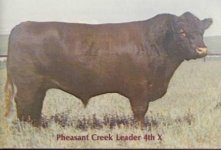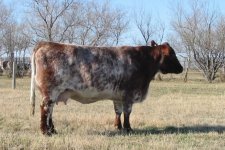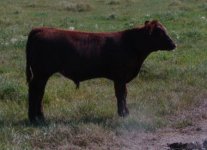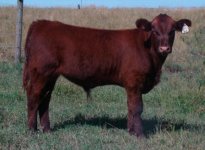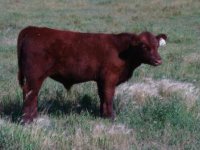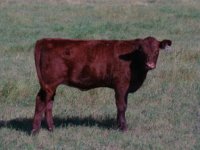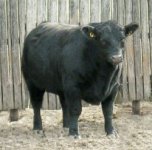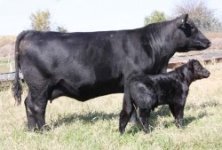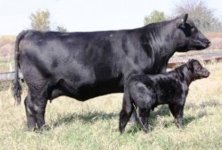trevorgreycattleco said:
Stinks thats the last of the semen on him. I like the bull. How do his calves grow so far? Whats your plans with the calves now? Were you hoping for bulls or heifers from this mating? Both perhaps? He looks like a easy keeper to me.
When Remitall dispersed in 1972, we purchased the 1/3 semen interest that was offered in him. We got about 300 doses of semen from him and used it extensively through the 70s and early 80s. The Leader 4th cattle were born easily, dark colored, polled, and easy fleshing. They were very correct, thick and apple smooth. They were very moderate framed like almost all cattle from that era. His sire Kinnaber Leader 6th was a 2300 lb bull in pasture condition. His dam was a cow named Hi Way Honeysuckle that came from the Walter Larsen herd at Carrington, ND which was one of best herds of polled Shorthorns at that time. I still consider Hi Way Honeysuckle in the top few females I have seen in my lifetime. She was a tank... yet moderate framed, great uddered and wide based. I would say she would be one of the most sought after females in the breed if she was alive today. From memory, I would estimate she would have been a female that stayed between 1500-1600 lbs and stayed in show shape while nursing a calf on grass alone.
I kept the semen on the farm, in one of my semen tanks and there was about 170 vials left when the semen tank burst and lost and I lost all the Leader 4th semen, along with 36 embryos we had collected in the early 80s. I was just sick ( to say the least). Along with all the Leader 4th semen we lost all the embryos we had from the full Irish females we had imported, and some sired by Dividend. I thought we would never have the opportunity to use Leader 4th ever again.
In November 2008, Marvin Peters from Prince Edward Island came west to help us show at Canadian Western Agribition. One evening as we were eating supper, I mentioned to him that I had sold some semen to a breeder in PEI many years ago but I could not remember the man's name. Marvin started to name people who had Shorthorns or had once owned Shorthorns, and when he mentioned one name, I stopped him and told him that I thought he had just named this man. Marvin said this man had dispersed his cattle years previously and it was highly unlikely that he had kept any semen. He called his home and got the phone number for this man and then phoned him. He said that he had dispersed his cattle in 1981, which was 27 years previous, but he said he had kept his semen tanks full of nitrogen and still had some Shorthorn semen. He said he had no idea why he had kept his semen but fortunately he had. I spoke with him on the phone and I asked him to check his tank and see what semen he had. When he phoned back a few minutes later, I almost jumped for joy as he had 6 vials of Pheasant Creek Leader 4th as well as semen from several other bulls from the 60s and 70s. I got 14 vials of Cumberland Gay Lad, 2 Scotsdale Rodney, and 2 Banner Royal Oak, along with the Leader 4th.
So far, I have only used the Leader 4th semen in the flushes. I used some of my bigger framed donors as I wanted to make sure the resulting calves had some performance along with the qualities some of these older genetics offered. We have 7 ET Leader 4th calves this year, 2 of which are from Shadybrook Presto 73G ( and these calves are owned with a SP regular, Todd Clarke from Des Moines, IA) and 5 from B Good Red Sue 1P. In these 7 there are 2 heifers and 5 bulls. All are solid red, polled, with BWs between 77 lbs and 88 lbs. The heaviest two calves, at 85 and 88 lbs, were the two heifers which I found interesting! For a long time, all 7 calves were like clones as they were almost exactly the same. In the past few weeks they have been starting to change, so much that I change my mind on almost every trip to the pasture, as to which one I like the most. They are thick, extremely long bodied and moderate framed. They appear to have a softness to their make-up that many of today's cattle lack. They appear to be very structurally sound in their design. Todd Clarke has one bull and one heifer from his Presto X Leader 4th calves. He was here this week and saw the calves for the first time. He has decided that he will keep the heifer as he feels she has tremendous potential as a future brood cow and donor. The other heifer is out of Red Sue 1P, and I may sell her as a feature lot in our Sun Country Female sale on October 20th. All the bulls will go on test this fall and they will be offered in the Sun Country bull sale next April. The only reason I would even consider selling my Leader 4th heifer is because I have some embryos remaining from the flush to Red Sue 1P and I now have 15 from Six S Leah 55L. I will probably retain the right to one flush from this heifer.
I was actually hoping for more bulls than females, and that was exactly what I got from the first 7 born. We actually had 8 pregnancies from 9 implanted embryos, but one of the recips died during the winter, when she rolled over on her back in a hollow and bloated. The calves appear to be growing very well, but they appear to have a different growth pattern to our calves from modern sires. I think they have just entered a period in their lives where they are going to get better and better with every day that passes.
From the 6 vials of Leader 4th semen I got 31 embryos. The semen was froze in 1970, or 40 years ago, and my ET vets told me it was some of the very best semen they had used in a flush in many years.

